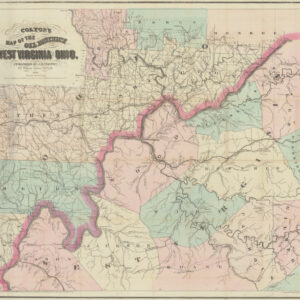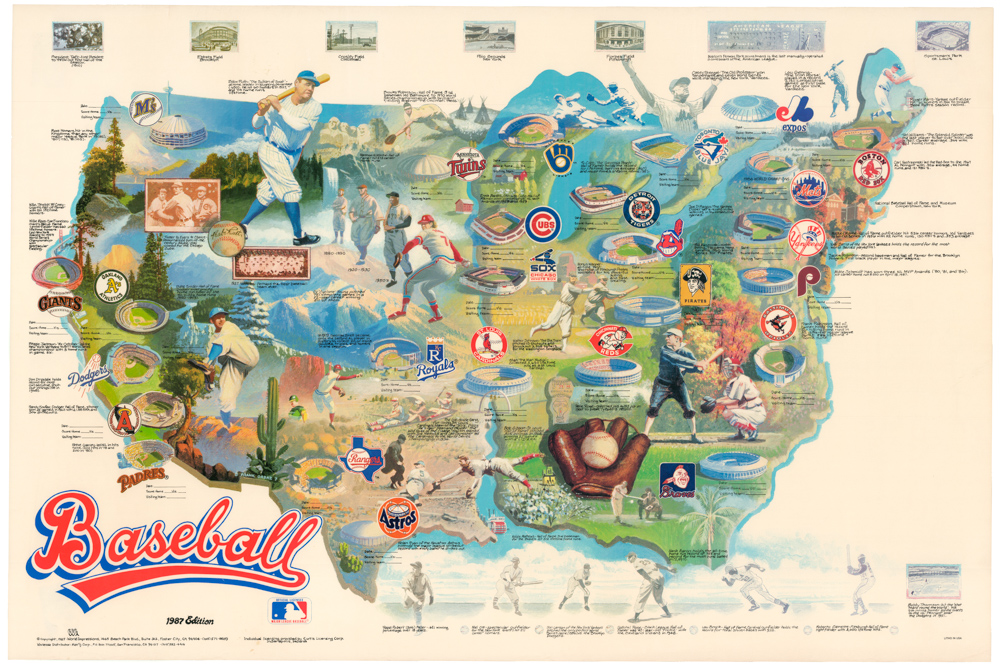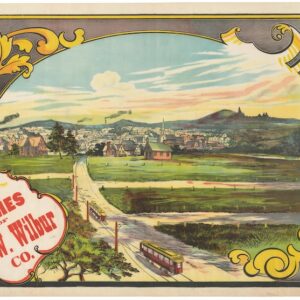A superlative copy of the finest 17th-century English map of New England, with fantastic old color and red-ruling denoting a noble English provenance.
A Map of New England and New York.
Out of stock
Description
John Speed’s Map of New England and New York is one the most significant colonial maps of the New World and a quintessential milestone in the history of British colonial cartography. It was compiled by the most prominent English mapmaker of the 17th century and stands a testament to his unrivaled skill, insight, and artistic prowess. It demonstrates why Speed was England’s leading cartographer during the Baroque.
This example of Speed’s Map of New England and New York has two distinguishing features that make it unlike any other example we have seen. The first is its striking old color. While countless Speed maps have been subjected to later or modern coloring to enhance their beauty, maps by John Speed in original 17th-century color are of the utmost rarity. The second feature is a rare phenomenon in 17th-century cartography known as red-ruling. Together, the coloring and red-ruling strongly suggest a provenance of considerable pedigree.
Red Rubrication: A mark of noble origins
Surrounding the printed space of the map, we find hand-drawn or ruled double lines in red ink. Such marginal lines are known as red rubrication or red-ruling. The addition of red lines was a popular practice among English nobility and social elites during the 1670s and 1680s, with important and affluent clients ordering their atlases in this way from the publisher. Red-ruling was usually limited to the margins of a map, but in some cases – especially when the maps were considered of seminal importance – the map’s title would be underlined in this manner as well.
The phenomenon was usually associated with atlases produced in England by English mapmakers. Examples of red-lined maps from Ogilby’s Britannia or Moses Pitt’s English Atlas are relatively common, primarily found in atlases belonging to institutional or generational collections. Rubricated or red-ruled Speed maps also occur but are considerably rarer than his contemporaries and often limited to maps of Britain. Finding one of Speed’s important colonial maps with both original color and the red-ruling of margins and title is extraordinary.
A Reflection of Changing Times
During the 17th century, the Dutch and English fought two wars of supremacy over the eastern seaboard of North America. This chart was crafted shortly after the English triumph over the Dutch in the Second Anglo-Dutch War (1665-67), which gained them control of New York and New Jersey. Speed’s map embodies that pivotal moment in American history. Following the English subjugation of Dutch towns and settlements, the provinces were quickly given new English place names. Thus New Amsterdam became New York, and provincial New Netherlands was renamed New Jersey. By providing the conquered provinces with new names, John Speed’s map expertly captures the evolving geopolitical landscape and shows clear and understandable favoritism to the English claim.
Features and Settlements on the Map
Speed’s map acknowledges all of the significant settlements of the era, and the map includes important colonial towns such as Boston, New Plymouth (Massachusetts), New Castle (Delaware), New Haven, Stamford (Connecticut), and Ft. Orange (modern Albany) – in some cases for the first time. Philadelphia is not on the map, but this is because it was published several years before its founding in 1682. This omission adds both to its historical charm and its appeal to collectors. Besides its new label, New York itself has not been particularly emphasized, though both Manhattan and Staten Island are neatly delineated. Yet Speed does not neglect the importance of integrating the nascent city within the colonial framework of the English and does so by including New York in the map’s title.
A Mosaic of Source Material
For the outline of coastal New England, Speed’s map draws from various cartographic sources and blends the work of earlier English cartographers, including Captain John Smith. The depiction of Long Island, the Hudson Valley, New Jersey, and the Delaware Basin relies more on Dutch sea charts produced during the Golden Age of Dutch cartography – in particular, Jan Jansson’s map of the region from 1651. By merging Dutch maps with the latest English information, Speed enhances many of the coast’s features. New takes are seen in the portrayal of the head of Chesapeake Bay or the delineation of the Susquehanna River.
The Enigmatic Interior
Even though the map is remarkably detailed in many ways, the interior regions beyond the Hudson and Connecticut Valleys are still a mystery in this phase of America’s colonial history. Indigenous tribes and the French control of the St. Lawrence Valley made gathering information about the northern territories challenging for English and Dutch cartographers. These difficulties explain some of the map’s more speculative elements.
The most obvious example is the strange configuration of the St. Lawrence River. While this region was still beyond the reach of the English, their ambitions shine through in the labeling of the eastern St. Lawrence as “the great river of New England.” Other examples of Speed’s speculative cartography are seen in the placement of Lake Champlain (Lake of Irocoisiensis) well to the east of its actual location or the Delaware River’s strange connection with the Hudson.
Artistic Flourishes
Beyond its historical significance, Speed’s map delights the eyes with finely-engraved depictions of woodland animals scattered across the unexplored interior. A bear, a deer, an otter, and several beavers add artistic elegance to this cartographic masterpiece and underscore the heritage of Dutch mapmaking that is embedded within it. The title cartouche in the lower right is topped with the Royal Arms of England, stressing the prestige and importance of substantiating the English claim.
Concluding remarks
John Speed’s Map of New England and New York is a valuable historical artifact and a stunning example of English colonial cartography. The historical context in which it was compiled, combined with the map’s accuracy and exquisite artistry, makes it one of the most exciting depictions of colonial America ever created. Neatline’s example nevertheless represents something even more desirable. The combination of its incredible state of preservation, its vivacious 17th-century coloring, and the red rubrication indicating a noble provenance make this the finest example of Speed’s map we have ever seen on the market. It is a true and rarified cartographical gem.
Census
John Speed’s map is one of only a handful of English maps of New England produced prior to 1700. Speed worked primarily from Jan Jansson’s map from 1651 for the geography. However, with the capture of New Amsterdam in 1664, a new set of placenames was necessary, and Speed provided precisely that. Most of the Dutch names have been replaced with new English vocabulary. Toponymic focus is not limited to the former Dutch territories alone but also includes significant improvements in the geography of New England, such as the first instance of Boston being noted on a regional map such as this.
The map was issued by Thomas Basset and Richard Chiswell around 1676 in a posthumous edition of John Speed’s atlas Prospect of the Most Famous Parts of the World, which also included other important maps of the New World.
Speed’s map can be found in a number of institutional collections, such as The British Library (OCLC no. 1064286042), Yale, and the New York Public Library (OCLC no. 47229010).
Cartographer(s):
John Speed (1552-1629) was a prominent English mapmaker and historian operating in the late 16th and early 17th centuries. Born in Farndon, Cheshire, Speed’s interest in maps and geography led him to establish himself as a successful mapmaker and publisher in London. He gained widespread recognition for his detailed and beautifully illustrated maps of various regions, earning him the sobriquet “the leading London cartographer” of the Baroque period.
One of Speed’s most notable works is The Theatre of the Empire of Great Britaine, published in 1611. This ambitious atlas consisted of detailed maps of counties and cities across England, Wales, Scotland, and Ireland, accompanied by historical descriptions and genealogical tables. The atlas was not only a cartographic achievement but also a significant historical record of the British Isles during that era. Speed’s maps were praised for their accuracy and artistic flair, often featuring decorative elements and engravings of notable landmarks and figures. When it came to Britain’s colonial aspirations, Speed was instrumental in visualizing the empire cartographically.
Both during his life and after it, John Speed’s maps enjoyed widespread popularity and were sought after by nobility and scholars alike. Speed reached the ripe age of 77, and his maps were re-published for more than a century after his death. His legacy as a key figure in the development of English cartography endures to this day.
Thomas Basset & Richard ChiswellThomas Basset (died 1699) and Richard Chiswell (1639-1711) were English publishers and booksellers who operated during the late 17th and early 18th centuries. They were known for their partnership in the London book trade and played significant roles in the production and distribution of books during their time.
Condition Description
Original outline color, title and margins double-ruled in red.
References
Campbell, "The Jansson-Visscher Maps of New England," 23, in Tooley, Mapping of America 290-291; McCorkle, Early Printed Maps of New England 676.6.





